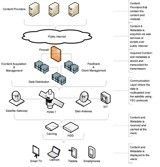
-
StatusCompleted
-
Status date2014-01-15
The aim of the project is to develop a system for multicasting popular multimedia content to end users of a satellite broadband service. By accurately predicting popular content, the system can lower the total bandwidth use for the satellite broadband operator. At the same time, the system can enhance the use experience of watching video and similar content from an online source.
The project's main premise was that the demand for video rich media is rapidly gaining popularity over the traditional internet. In the UK and worldwide, the demand for video over the internet is increasing at a lightening speed with the increase in fast broadband connections to homes and the emergence of more service providers that are offering content streaming services on a commercial and non-commercial basis.
Although it is a win-win situation for service providers and end users, the demand in the market has proven problematic to the ISP’s who gain no or little from providing “fat pipes” for enabling these services to their users while bearing the costs of providing and running the infrastructure.
Project NXY looked at addressing the issue of content delivery to the satellite broadband end users that used the services during the pilot of the project and the technical and commercial implications on the satellite broadband provider who operated the service.
For satellite broadband providers, the challenge is to provide a high quality user experience while keeping the costs of delivery down. A key to this is making use of the satellite’s intrinsic quality to cost effectively multicast content.
During the project the following key issues were discovered at various stages in the project:
- Content plays a very important role in an IPTV/VOD type of system and acquiring premium content from content providers is more of an uphill task even where public broadcasters are involved.
- Technically the implementation and pilot has proven that such a system is feasible over the satellite and it brings advantages to the users and the satellite operators in terms of bandwidth and network management.
- There is no one size that fits all for creating a commercial feasibility for such a service provisioning and each operator will need to adapt accordingly depending upon where the organization lies in the value chain.
The NXY system is expected to provide the user with an enhanced on-demand video experience with respect to availability, latency and jitter. At the same time, the service provider’s overall bandwidth usage is expected to be lower.
Project NXY successfully designed, developed and implemented an IPTV / VOD end to end solution which was capable of acquiring content and metadata from various sources (content providers) such as BiBC and Lancashire One, and multicast the same to the end users via the satellite using NORM (NACK Oriented Reliable Multicast) protocol that is FEC (Forward Error Correction) based protocol, which ensured the delivery of the multicast to the user clients. The client Cache was ergonomically designed and implemented to enable the users to consume the content.
The high level architectural overview depicted in the figure above shows the various components that were used during the project NXY.
- NXY CMDC
The NXY Content Management and Distribution Center (CMDC) is the server side of the NXY system and contains three subcomponents.- NXY Content Acquisition and Management Server
This sub component is responsible for acquiring the content from Content Providers over the internet and managing the acquired content locally. - Data Distribution Server
This subcomponent is responsible for distributing the content to the clients via satellite broadcast. The Data Distribution Server sends the content to the satellite hub, which forwards it to the Satellite Gateway to be broadcasted by the satellite. - Client and Feedback Management Server
This subcomponent is responsible for managing the software of the client routers, as well as accumulating the statistics feedback received from the clients.
- NXY Content Acquisition and Management Server
- NXY Client Unit
This represents the Customer Premise Equipment (CPE) which will be installed at the customer premise in order to cache and view content that is transmitted from the NXY CMDC. The NXY Client Units consists of the following subcomponents:- NXY Router
This is a router with customized firmware which communicates with Satellite Interactive Terminal (SIT), in order to receive and send data to the NXY CMDC. - HDD Cache
This is the hard disk where the content will be cached, so that it can be viewed by the customer.
- NXY Router
NXY Player
NXY Pilot:
- During the pilot phase of the project the NXY caching equipment was distributed to 65 locations across the UK, where 35 locations included new VSAT equipment installation’s where 30 were existing satellite broadband users. The locations involved DTH (Direct to Home) users and community caches in Wray which equated to approximately 300 users.
VSAT Installations
The project was planned to take place over 18 months in a step by step approach:
- Requirements
During the requirements phase the system and user requirements were established. - Design
During this phase, a design for each of the elements of the system was produced. The design of the system was validated against the user and system requirements. - Implementation
Implementation phase saw all the constituent elements of the system come together. - Trial
The objective of the trial was to understand the behaviour and experience of the end users and gather experience of operating the service. The services were trialled with proximately 300 users, which comprised of DTH (Direct to Home) users and (Community Cache) users. - Commercial Feasibility
During the final phase, trial results were analysed to determine the commercial feasibility of the service on a wider scale taking into account the practical results, the costs of equipment provisioning and potential revenues and savings.
The project objectives were met successfully by firstly implementing a fully operational end to end IPTV/VOD service that utilised the Hylas 1 satellite for multicasting and conducting a Pilot with approximately 300 end users that were involved in the feedback and evaluation process of the system.
The project was completed on the 18th of June 2013, with the Final Review meeting conducted at ESTEC.






